Article Author: xparadigms
Article Translation: Block unicorn
Key Points
- USDT has become the dominant stablecoin, with its market capitalization growing from $80 billion to $144 billion over the past year, but its market dominance has decreased from 70% to 61% as other stablecoins also expand.
- Tether USDT natively supports about 12 blockchains, while bridged versions of USDT exist on over 80 blockchains, introducing additional risks and management challenges due to reliance on third-party bridges and lack of direct oversight from Tether.
- Tether addresses scalability challenges through horizontal strategies (such as using LayerZero OFT for cross-chain transfers with the USDT0 multi-chain token) and vertical strategies (such as supporting Arbitrum's Legacy Mesh and the Bitcoin sidechain Plasma), aiming to unify liquidity and build dedicated ecosystems.
- As stablecoin issuers expand, interoperability has become the first step in scaling. LayerZero provides customizable infrastructure and extensive blockchain support, becoming a major entry point for this cross-chain growth strategy.
Introduction
USDT has transformed the dollar into a global digital asset by bringing it on-chain. It has become the largest stablecoin, with a market capitalization exceeding $140 billion. Despite facing numerous rumors about insufficient collateral in the past, it has maintained its position as the leading stablecoin. As the stablecoin market expands, the market capitalization of Tether USDT has grown from $80 billion to $144 billion, an 80% increase over the past year.
While USDT continues to grow, other stablecoins are also expanding, leading to a decline in USDT's market dominance from 70% to 61% over the past year. To maintain growth, USDT has taken bold steps to expand its cross-chain capabilities, from implementing the multi-chain token USDT0 supported by LayerZero OFT to building hubs centered around Legacy Hub and Plasma. Through these methods, they are addressing past challenges.
Let’s first look at the issues they face.
1. Tether USDT Expansion Plan Issues
1.1 Tether USDT Only Supports 12 Chains
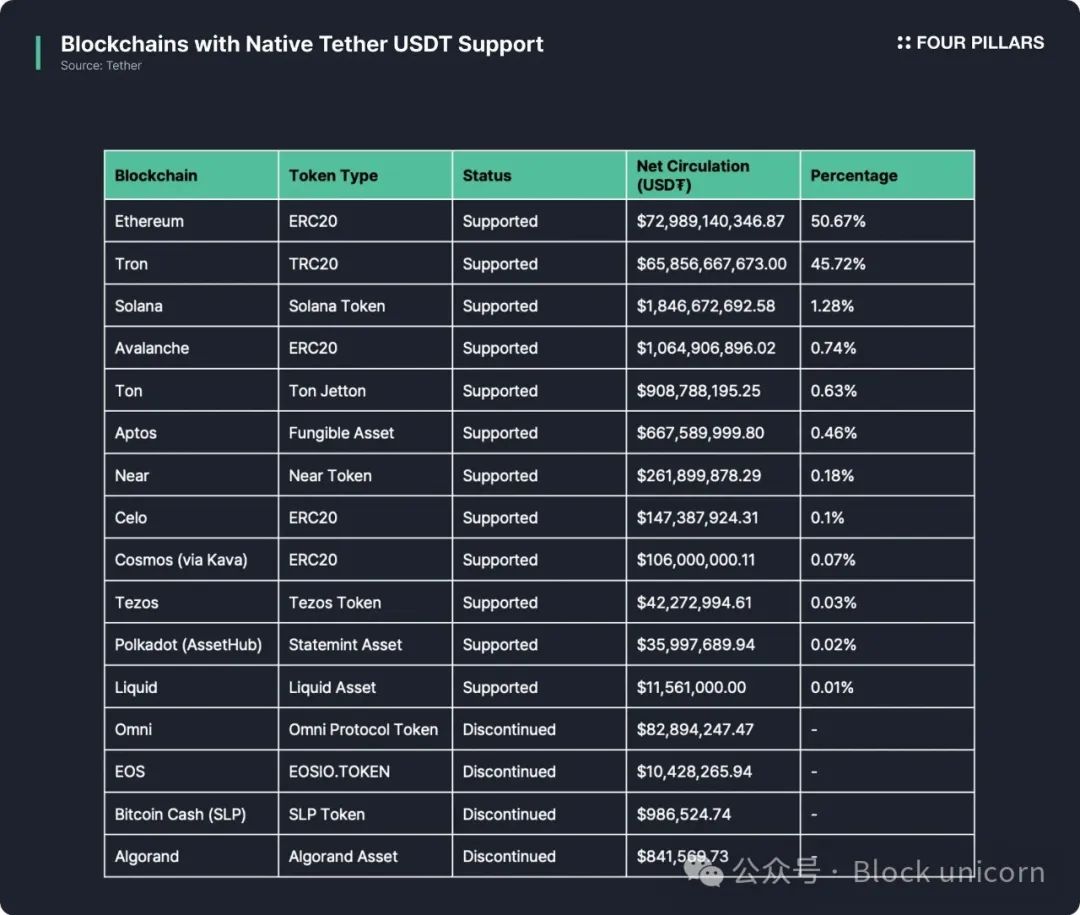
Source: Tether Official Knowledge Base | Supported Protocols and Integration Guide
In 2014, Tether launched the stablecoin USDT on the Omni Layer protocol on the Bitcoin blockchain. Over the years, Tether has expanded USDT issuance to other major blockchains, including Ethereum (ERC-20), Tron (TRC-20), Binance Smart Chain (BEP-20), Solana (SPL), and others. As of early 2025, Tether natively supports USDT on about 12 blockchains. Nevertheless, data from DeFiLlama shows that USDT exists on over 80 blockchains. Notably, USDT on more than 50 of these blockchains is valued at over $1 million, and among the top 30 blockchains by USDT trading volume, 17 rely on bridged versions of the token rather than native support.
When USDT is not natively supported on a blockchain, it means that Tether does not directly issue or redeem USDT on that chain. Instead, third-party bridges lock native USDT on supported chains and issue corresponding "wrapped" or "bridged" versions on the new blockchain. For users, this introduces compatibility issues with bridged versions and an additional layer of risk. The security and reliability of bridged USDT depend entirely on the third-party bridge operators, not Tether itself. If a bridge is hacked or encounters issues, users may lose bridged USDT, and Tether is not responsible for these losses. Only USDT on natively supported blockchains is directly backed and redeemable by Tether, so holding bridged USDT means relying on the solvency and security of the bridge.
Additionally, due to low usage or security issues, Tether has stopped minting USDT on several blockchains. These include Omni Layer on Bitcoin, AssetHub on Kusama, Simple Ledger Protocol (SLP) on Bitcoin Cash, EOSIO.TOKEN on EOS, and Algorand. While redemption may still be possible for a limited time, no new USDT tokens are being issued on these networks.
Although USDT appears to be widely available across various blockchains, only a few chains receive native support from Tether. On all other chains, users interact with bridged versions of USDT, which carry additional risks not applicable to native tokens.
1.2 Bridged USDT is Increasing
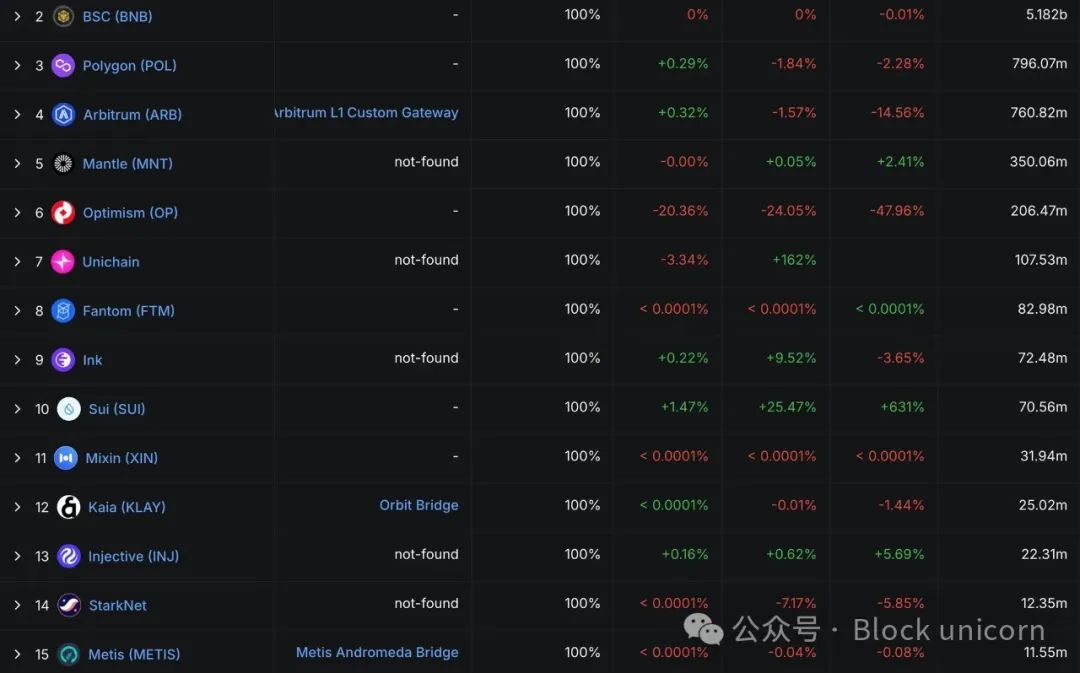
Source: Tether: Circulation and Statistics - DefiLlama
Currently, the circulating supply of USDT on Ethereum is approximately $64.94 billion, with about $8 billion of USDT bridged to other blockchains. For example, approximately $5.2 billion of USDT has been minted on the Binance Smart Chain (BSC) through the BSC bridge. Additionally, several major Layer 2 networks—such as Arbitrum, Polygon, Optimism, and Mantle—operate their own native bridges for USDT transfers. Other Layer 1 blockchains, including Fantom, Kaia, and Sui, rely on third-party bridges to facilitate the movement of USDT between chains.
From Tether's perspective, the growth of bridged USDT presents significant management challenges. Tether can only directly monitor and control the USDT it issues on natively supported networks. Once USDT is bridged to other chains via third-party bridges, Tether loses direct oversight of these tokens. This fragmentation makes it increasingly difficult for Tether to track total supply, ensure compliance, and manage the risks associated with the expanding number of blockchains and bridging protocols.
Ultimately, while the rise of bridged USDT enhances liquidity and interoperability within the crypto ecosystem, Tether, as the issuer, also faces new complexities.
1.3 Tether is Leaking Value to Tron
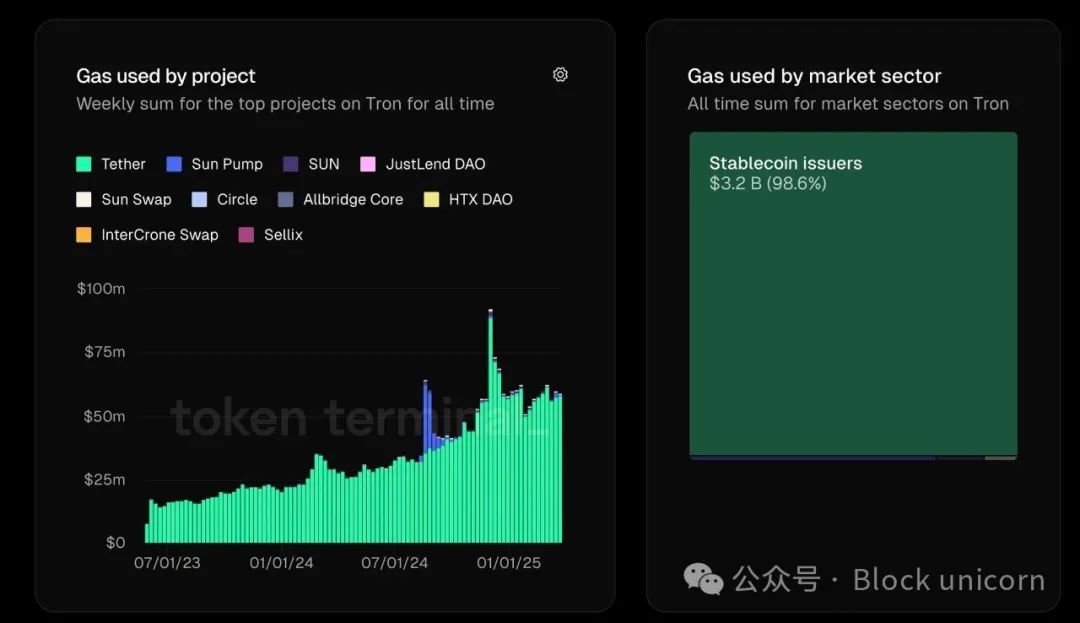
Source: Tron Gas Usage | Token Terminal
Stablecoins are the backbone of on-chain finance, serving as the primary medium for settlement, trading, and lending. This phenomenon is particularly pronounced on Tron, where stablecoin-related transactions account for the vast majority of on-chain activity—USDT alone constitutes over 98% of the stablecoin supply on the Tron network, nearly encompassing all trading volume.
Currently, the total market capitalization of stablecoins on Tron is $71.5 billion, with USDT dominating at over $70.9 billion in circulation, far exceeding other stablecoins like USDD, TUSD, and USDC, which make up only a small portion of the market. This dominance is so thorough that Tron can be referred to as the "USDT chain," with 98% of transaction fees and 99% of transactions driven by USDT transfers. As a result, Tron captures over $2.5 billion in annual fee revenue from these activities.
But this raises a critical question: what if Tether, the issuer of USDT, launched its own blockchain, capturing not only transaction fees but also the ecosystem value currently flowing to Tron? Tether has demonstrated the ability to quickly mint and move billions of USDT to meet market demand, frequently adjusting supply across blockchains to optimize costs and efficiency. If Tether incentivized major centralized exchanges (which currently hold about 30% of USDT on Tron) to migrate their USDT holdings to a Tether-operated chain, it could redirect network activity and fee revenue back to its own ecosystem.
This move could fundamentally reshape the economic model of stablecoin infrastructure. For exchanges and users, migrating to a Tether native chain could mean lower fees, faster settlements, and potential rewards for early adopters. For Tether, this would unlock new revenue streams and enhance control over its stablecoin environment.
In the long run, this could create a win-win situation: users and exchanges benefit from a layer designed for efficient settlement, while Tether captures the value currently leaking to third-party blockchains. Given USDT's dominance on Tron and the broader crypto ecosystem, the opportunity for Tether to internalize this value is both significant and increasingly feasible.
2. Tether's Strategy - Horizontal and Vertical Expansion
To address the issues facing Tether USDT, there are two potential solutions. The first is horizontal expansion through better cross-chain strategies implemented across the existing 300+ blockchains, continuing to grow. The second is vertical expansion by owning the infrastructure stack to capture more value and provide additional services.
2.1 USDT0 - Horizontal Expansion Using LayerZero OFT
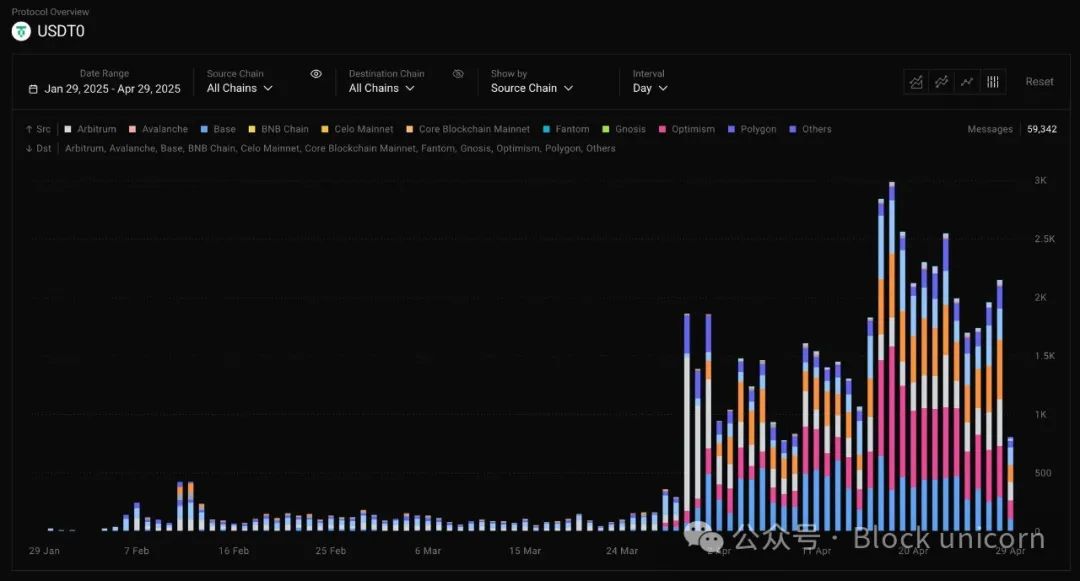
Source: LayerZero Scan
Tether has launched its multi-chain version of USDT, called USDT0. This token now easily expands to other blockchains or Rollups using LayerZero's OFT token framework. Since its launch a month ago, its total locked value (TVL) circulating supply has reached $971 million, with total cross-chain transaction volume exceeding $3 billion. The cost of sending USDT across different blockchains is now lower than ever.
This is thanks to LayerZero's OFT standard, which allows tokens to be locked or burned on the source chain and minted on another chain. USDT can be locked on natively supported chains such as Ethereum, Tron, and TON, and then minted as USDT0 on unsupported chains like Arbitrum, Optimism, and Berachain. For transfers between unsupported chains, the system uses a burn-and-mint mechanism. This approach simplifies supply management across different networks while reducing the need for native support.
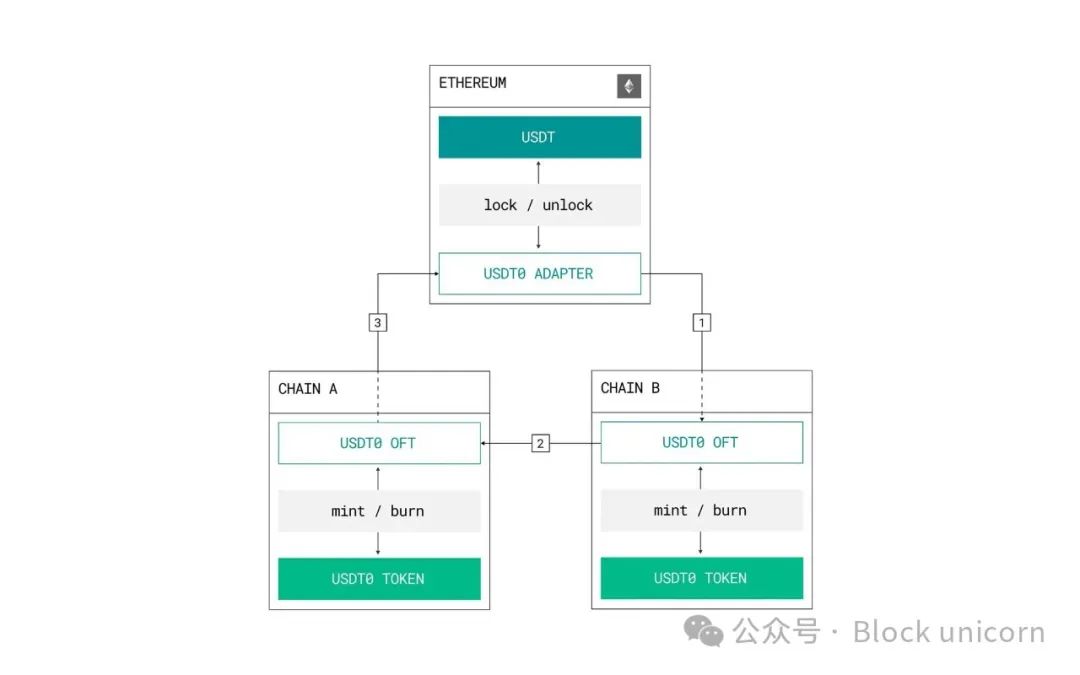
Source: "USD₮0 Mechanism Design Review" | Chaos Labs
LayerZero implements "issuer-aligned interoperability," with cross-chain operations of USDT0 verified by two real-world validators: USDT0 DVN and LayerZero DVN. This means that cross-chain transfers can only occur with the approval of the infrastructure operated by the issuer of USDT0.
To support new chains for USDT0, two conditions must be met: LayerZero must support the chain, and the team must find or initiate support for the chain's DVN routing. Currently, LayerZero supports about 131 mainnets, including most major networks, so the expansion of USDT0 is more of a strategic decision than a technical barrier.
2.2 Legacy Mesh and Plasma - Building Hubs for USDT
Tether achieves vertical expansion by supporting two key initiatives: building Legacy Mesh for USDT0 and the Bitcoin sidechain Plasma. Legacy Mesh acts as a central network connecting existing USDT deployments with USDT0 (the multi-chain version provided for chains lacking native USDT support). Arbitrum serves as a central hub, facilitating inter-chain transfers by aggregating liquidity pools and using LayerZero's communication protocol. This allows users to seamlessly move assets between Ethereum, Tron, and TON and USDT0-supported networks (such as Arbitrum, Ink, and Berachain). With Arbitrum's connections to Ethereum, Tron, and TON, it unifies 98% of the USDT supply, while Legacy Mesh creates a tightly integrated ecosystem for stablecoins across mature and emerging blockchains.
The second initiative, Plasma, takes a bolder approach by building a Bitcoin sidechain focused on payment efficiency. From day one, USDT0 will be supported on Plasma, maintaining a direct connection with USDT on Ethereum, Tron, and TON.
Together, Legacy Mesh and Plasma create a comprehensive liquidity and ecosystem hub for USDT. Arbitrum serves as the liquidity pillar, while Plasma optimizes transaction throughput and develops its own dapp ecosystem. This synergy allows USDT to expand its influence in both liquidity and application.
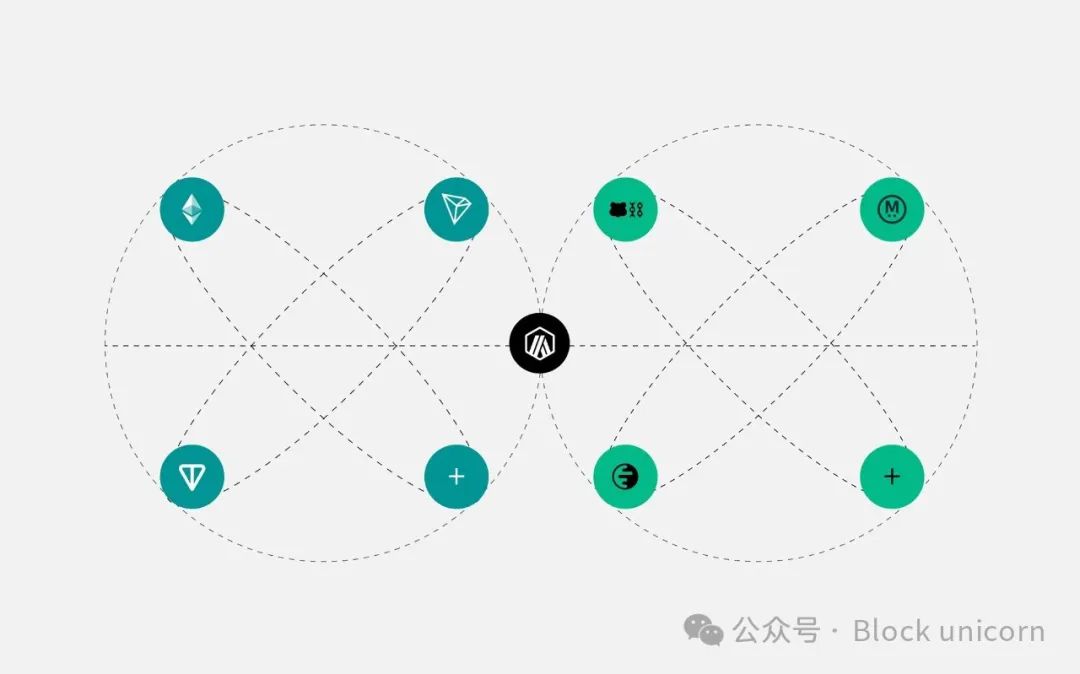
Source: "Introducing Legacy Mesh: Your USDT Anytime, Anywhere, Now Ubiquitous" — USD₮0
3. Interoperability is the "First Step" in Stablecoin Expansion Strategy
Stablecoins make fiat currencies semi-global currencies, while interoperability makes stablecoins truly global currencies. As the blockchain ecosystem expands to over 300 networks, the use cases and user base for stablecoins become increasingly fragmented. For stablecoin issuers, an early focus on a single chain may be effective, but long-term growth and adoption depend on cross-chain strategies that allow their tokens to move seamlessly across multiple blockchains.
A typical example is the Wyoming Stablecoin (WYST), the first fully reserved, state-issued stablecoin in the U.S. By partnering with LayerZero and adopting its OFT standard, WYST can be issued and used across multiple major blockchains, including Ethereum, Avalanche, and Solana. This interoperability not only expands WYST's user base but also reduces operational costs, improving the experience for institutions and individuals that need to transact or settle across different networks.
The example of WYST highlights a broader industry trend: interoperability strategies must keep pace with issuance strategies. As stablecoins seek larger-scale adoption, LayerZero, with its customizable infrastructure and extensive chain support, is becoming the entry point for cross-chain expansion, enabling issuers to efficiently enter new markets and use cases.
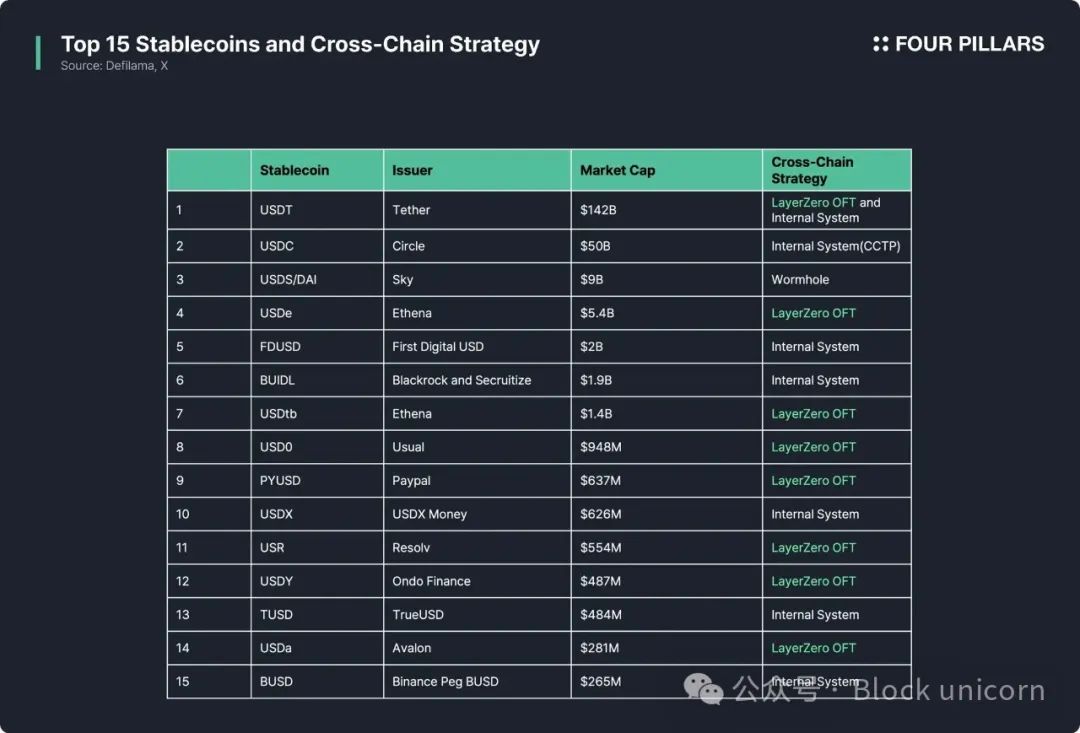
Source: "Accelerating the Development of Asian Stablecoins through Interoperability" | Four Pillars
免责声明:本文章仅代表作者个人观点,不代表本平台的立场和观点。本文章仅供信息分享,不构成对任何人的任何投资建议。用户与作者之间的任何争议,与本平台无关。如网页中刊载的文章或图片涉及侵权,请提供相关的权利证明和身份证明发送邮件到support@aicoin.com,本平台相关工作人员将会进行核查。




